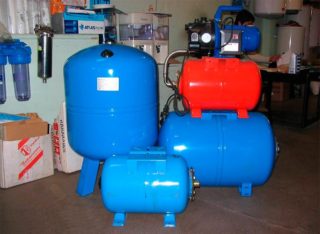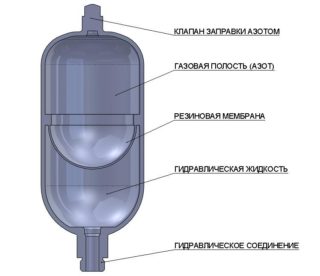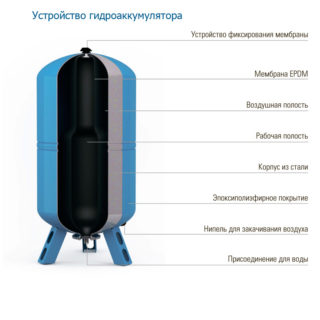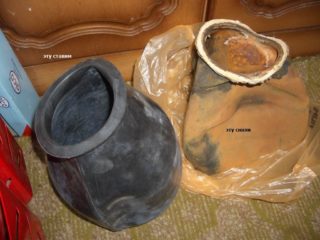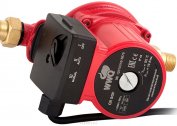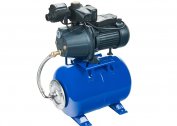The capacity for the accumulation of fluid in the water supply system is the most important element after the pump, therefore, its choice should be taken seriously. There are many different options for the implementation of this node, so that people are comfortable using the water supply. The selection criteria are based not only on the volume of the accumulator, but also on the method of attachment, internal design.
The purpose of the accumulator
The main function of the accumulator is to accumulate fluid and maintain pressure in the plumbing system. To do this, this unit is equipped with a pressure gauge and relays that withstand a certain period, at the extreme points of which the pump turns on and off automatically.
Do not confuse the hydraulic tank and the expansion tank. The second is needed in the heating system in order to compensate for losses due to evaporation of hot liquid, as well as to take on the excess air that occurs when the water in the boiler is heated.
Water hammer is a dangerous phenomenon for plastic pipes. It occurs during the oncoming movement of the liquid: a sharp closing of the valve stops the flow, and it begins to move in the opposite direction, colliding with a wave coming from the pump. At a certain point, too much fluid accumulates in the pipe, which can break plastic and even metal. The hydraulic accumulator inhibits the formation of water hammer, as it is a buffer between the pump and the point of water consumption.
If the water supply system of a private house is not equipped with a storage tank, this means that a powerful submersible pump or station will turn on every time someone opens a tap at the top. The resource of the pump is limited by the number of on-off cycles, and also has an indicator - the maximum allowable switching frequency. On average, equipment should turn on 5 times per hour. The constant operation of the unit affects the details much less than frequent switching on. Due to the liquid supply, the hydraulic accumulator allows reducing the response rate by 2–3 times, therefore, another of its functions is protection against wear of the electrical part of pumping equipment.
If the electricity is suddenly turned off, residents can continue to use the water in the house while the pressure in the hydraulic tank is maintained. The principle of operation of the accumulator for water supply systems is based on the balance of water and air inside the tank.
There are cases when the accumulator is not only not needed, but can even harm the pump. We are talking about the constant operation of pumping equipment when watering the garden. In this case, the tank cannot be installed, as the equipment will often turn on and off. When watering, it is better if it works in constant mode - this way the engine overheats and wears out less.
Residents can decide for themselves whether to put a tank or not, if the pump is equipped with a soft start system that prevents water hammer.
Application area
The hydraulic accumulator can be installed not only in a private house, but also in a high-rise building, so that during a water outage in the city, residents have a small supply. This allows you to maintain pressure and use household appliances - a washing machine or dishwasher.
A hydraulic accumulator with a membrane that is resistant to hot temperatures is used in the hot water supply system as an expansion tank, so when buying, you need to specify what function it will perform. The membrane for cold drinking water will not withstand boiling water. Rubber also differs - in domestic hot water it is technical, in water supply - food. Hydraulic tanks are connected to a boiler and to a double-circuit boiler.
In addition to domestic use, GA are used in many industries, for example, in the engineering industry.
Types of storage tanks
For domestic needs, two types of tanks are used:
- Membrane The rubber is fixed in the circlip. In such a tank, the liquid comes into contact with the walls, but only in one half of the accumulator. The second half is occupied by the air mixture, which can be vented or pumped as needed.
- Balloon. The fluid enters the rubber bulb attached to the neck when entering the tank. Water does not come into contact with the walls and does not affect the metal. On the other hand, there is the possibility of rupture of the pear and leakage of fluid through the nipple. In this model, membrane replacement is possible.
There is still a variant without a membrane, but for use in a private house in a water supply system, such a hydraulic accumulator device is inconvenient. The air will mix in the tank and go with the water, so it will have to be constantly monitored and pumped. You need to do this daily. Membraneless tanks are suitable for the accumulation of water for irrigation, outdoor showers.
Models of hydraulic accumulators are produced in vertical and horizontal versions. This is for convenience only. For example, in a small room in a bathroom, GA can only be installed under the ceiling in a horizontal position by attaching it to a wall. If the technical room is located in the basement, it is better to buy a hydraulic tank with legs and screw it to the concrete floor with bolts.
Principle of operation
The principle of operation of the GA is based on a change in pressure inside. This happens due to additional equipment - pressure gauge and relay. The incoming water stream fills the rubber bulb until the pressure rises to the level specified in the settings. Then the sensor works and the pump shuts off automatically. A tap is opened in the house and liquid is used for domestic purposes until the pressure has weakened to the lower indicated level. The sensor responds again and the pumping equipment turns on. This is how the accumulator works in the plumbing system.
When the hydraulic tank is connected to the heating system, it is triggered when the pressure in the boiler rises due to steam when heated. Excess steam is sent to the accumulator, from where it can be vented if necessary. In the heating system, fluid is lost and pressure drops. In this case, the GA gives a signal to replenish water, so that the quality of heating does not decrease.
Accumulator device
The case is made of various materials - durable plastic, metal or stainless steel. Stainless steel is more expensive, so there are fewer such models on sale. Plastic is also not recommended - it may crack upon impact.
The membrane is made of rubber food rubber, if it is intended for the storage of drinking water. There is also technical rubber, if it is designed for use for other purposes. The temperature regime of the membrane matters: in hot water supply systems it is installed heat-resistant, for cold water - ordinary. This must be considered when purchasing a replacement membrane.
Manometer - a device for measuring and adjusting pressure. Relay - a sensor that is triggered when the lower or upper limit of air compression is reached.
You can bleed air or upload a new portion through the spool using a bicycle or car pump.
A coarse filter is installed in the case in case the water contains solid fractions - sand or stones. They can accumulate in the membrane and damage it. The filter is placed in front of the rubber bulb.
Advantages and disadvantages of a hydraulic tank
Pneumatic accumulators have the following advantages:
- affordable cost;
- the ability to independently connect to the system;
- simple device;
- replaceable membrane;
- the ability to connect to any type of pump, as well as installing several tanks in parallel, so that the water supply does not stop if one of the accumulators breaks down;
- the ability to choose the correct amount of GA, but keep in mind that the volume specified in the instructions is the total number, there will be 2/3 less water in it;
- you can independently disassemble the structure and find a breakdown, as well as repair and replace parts without calling the master at home.
Among the drawbacks is the need for a separate room if the hydraulic tank is large and connected to a surface pump. Such nodes are usually very noisy, so they are isolated from residential premises. When buying an inexpensive hydraulic tank, frequent repairs may be required, which entails additional costs.
Criterias of choice
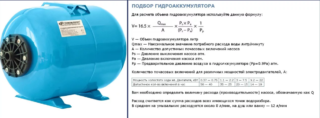 First of all, it is necessary to determine what functions the accumulator will perform. You may need several completely different models - for plumbing, hot water and heating. In this case, it is necessary to calculate the desired volume of each. Here you can not do without a specialist who will help determine.
First of all, it is necessary to determine what functions the accumulator will perform. You may need several completely different models - for plumbing, hot water and heating. In this case, it is necessary to calculate the desired volume of each. Here you can not do without a specialist who will help determine.
The next criterion is the budget. Imported models are more expensive, but made of high quality durable materials, whose service life is longer. If you choose among domestic GA, you need to choose not the cheapest, since they will work longer.
Having decided on the functions and budget, you can proceed to the technical part. Much depends on the quality of the well fluid. If the source does not have a filter installed on the casing, you must buy a model of a hydraulic tank with a filter so as not to clog the water supply.
You should calculate the amount of fluid consumed by all family members per day and find out how much tank to put. A reserve should be provided in case you need to purchase any household appliances or cut down the bathhouse. For a family of 4 people living in the house, you need a tank of 50 liters. At the same time, the house has a washing machine, shower, bathroom and faucet in the kitchen. The specialist can calculate the optimal amount of HA by a special formula, which includes the maximum allowable number of inclusions, indicators of lower and upper pressure, maximum water consumption per hour.
It must be taken into account that unused liquid stagnates and a smell of silt may appear in it, so an oversized tank is not needed.
Installation and Connection
For installation, you can use your own skills and experience. All connection steps are described in the instructions. Pre-set the upper and lower pressure threshold. You can leave the factory settings at which the lower limit is 4 bar, the upper limit is 8 bar. If the system does not work correctly, the settings are changed by twisting the large and small springs.
The tank is placed after the pump, connected using a fitting with three and five inputs. Two of them are designed for relays and manometers, the rest for pipes and flexible hoses to reduce vibration transmitted from the pump.
Before starting with the pressure gauge, once again check the pressure of the air mixture inside. Then you can turn on the system. If the relay operates correctly, the installation process is completed and the water supply can be operated.
Operational Features
During the operation of the accumulator, the following rules must be observed:
- check the pressure 2 times a year, if necessary - more often, pumping a new portion or bleeding excess;
- monitor for leaks - they may indicate a break in the rubber membrane and the need for replacement;
- monitor the operation of the pump - its frequent activation also indicates that the accumulator is not working properly due to settings or breakdowns.
The less the pump starts, the better. The maximum number of starts should not exceed 30 times per hour.
If it turns out that one tank is not enough, you can build another or even several. In this case, the system will function if any of them breaks down.
Service
The weakest point of the tank is a rubber membrane. In the process, it is constantly stretched and compressed. If the air pressure inside is small, the rubber will stretch more, which will eventually lead to its rupture. Then you have to buy a new one and change it yourself.
When the membrane ruptures, the pressure gauge will show sharp surges and pressure drops. When you press the nipple instead of air, water will flow out. This means that there is no air left, and the entire tank is filled with liquid. From the faucet in the house air will come out mixed with water.
When replacing rubber, make sure that its neck is firmly and evenly laid and secured with a flange. If the edge slips, water will flow out and the work will have to be done again.
Do not use sealant at the joints of metal and rubber. This leads to slipping and leaks due to loose fit parts.
Common malfunctions include breakage of the nipple when it does not close and releases air. The item can be purchased at the service center and replaced independently.
Prices for hydraulic tanks for water supply systems vary greatly depending on the brand of the manufacturer. German, Italian, Swedish manufacturers that supply high-quality equipment have long been working in the Russian market. Competition for them is made by domestic plants whose products do not differ in quality, but are slightly lower in cost. You should not buy cheap goods made in China, as they are mostly unsuitable for repair and do not last long. Spare parts for them do not supply, so the water supply system can be idle for a long time.
